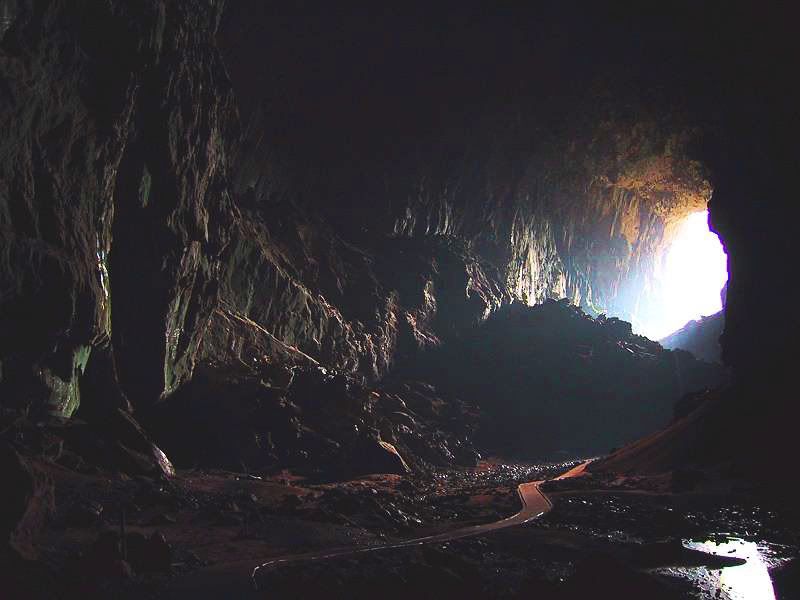
Wednesday, April 30, 2008
Tuesday, April 29, 2008
Monday, April 28, 2008
Black Taj @ Track & Field (3.1.08)
Sunday, April 27, 2008
Sandy Does the Subcontinent

Old chum Sandy O is on the road again, this time kicking up dirt in India. As usual she is blessing the internet community with a series of dispatches to document the experience, which seem to have a distinctly different timbre than her last sojourn. Hard to put a finger on it. Regardless, the peripatetic wordsmith is always worth the read. I found the following excerpt to be particularly interesting:
While despising an entire country is probably never fully justified, I have had a perfect storm of frustrations. It started when I was leaving the train station in Gaya - in my exhaustion I slipped and took a really bad fall down the slick marble stairs, with about three of the edges slamming me in the lower back. The impact was so hard that I blacked out briefly. I was terrified for a moment that I’d broken something in my back or somehow concussed myself. I looked up, half expecting help struggling out of the heavy pack and to my feet, since I was shaking so hard I couldn’t quite manage it, but aside from some blank staring, the crowds of passengers were just stepping over me. I realized in complete terror that I could die right there and no one would do anything except steal my stuff. I have never, ever seen such a total lack of compassionate humanity in people’s eyes in my life, and frankly, what I saw scared me. It was not the best opening to a stint of solo travel.
Aside from residual pain in my back, neck and shoulders, and not being able to lift my right leg, I pulled out of the physical effect in a day or so but the psychological impact wasn’t so easy to shake. It doesn’t help that everyone - and I mean everyone - here lies all the time, from the guy at the post office to people at the internet cafe. I would bet my life savings that if I went and asked right now how much a bottle of soda cost, they would say 25 rupees, even though the maximum retail price is printed clearly as 20. At least they’re consistent.
When they’re not lying, they’re just generally harassing you, unless of course they’re sleepy and then they just part their eyes enough to wave you dismissively out of their open shop before going back to having a snooze. Now I understand that Bihar is one of, if not the, poorest states, but I’d really like to retain at least a few of my liberal illusions, like the one that says poverty does not necessarily engender a culture of grotesquely dishonest, lazy and aggressive people.
Oh and then I started my period......
Sandy Does the Subcontinent

Friday, April 25, 2008
Thursday, April 24, 2008
Sunday, April 20, 2008
Friday, April 18, 2008
Dennis Hollingsworth: In search of the Sophic Hydrolith
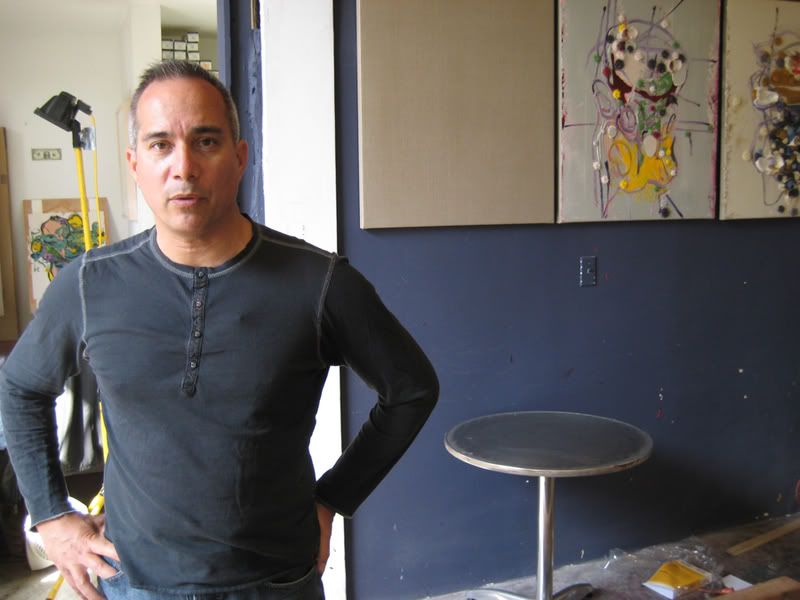 Dennis Hollingsworth
Dennis Hollingsworth It's fortuitous that Dennis Hollingsworth's show of new paintings at Michael Kohn gallery has arrived at the same moment that my investigation into the cthonic roots of shamanic epistemology has taken me into a study of the hermetic tradition of alchemy. Alchemy is a word that we don't often use in the sober, and leavened conversation of contemporary secular humanism, indeed it would appear to rest on the dusty shelves of historical curiosity for many as a zany misadventure and naive attempt to grasp the finer more elegant ratiocinations of scientism that, concurrent with a legion of progressive notions in both social and philosophical domains, arrived en masse as a wave of rational materialism pushed forth out of enlightenment thought and catapulted us into the mantic present. At first blush, alchemy not only appears to occupy the worldview of a less sophisticated time, but also seems to emerge from a milieu that we generally regard with suspicion and contempt: the world of tricksters and legerdemain, charlatans and raconteurs. How on earth can the invocation of alchemy possibly be now all the sudden relevant and without guile?
It's fortuitous that Dennis Hollingsworth's show of new paintings at Michael Kohn gallery has arrived at the same moment that my investigation into the cthonic roots of shamanic epistemology has taken me into a study of the hermetic tradition of alchemy. Alchemy is a word that we don't often use in the sober, and leavened conversation of contemporary secular humanism, indeed it would appear to rest on the dusty shelves of historical curiosity for many as a zany misadventure and naive attempt to grasp the finer more elegant ratiocinations of scientism that, concurrent with a legion of progressive notions in both social and philosophical domains, arrived en masse as a wave of rational materialism pushed forth out of enlightenment thought and catapulted us into the mantic present. At first blush, alchemy not only appears to occupy the worldview of a less sophisticated time, but also seems to emerge from a milieu that we generally regard with suspicion and contempt: the world of tricksters and legerdemain, charlatans and raconteurs. How on earth can the invocation of alchemy possibly be now all the sudden relevant and without guile?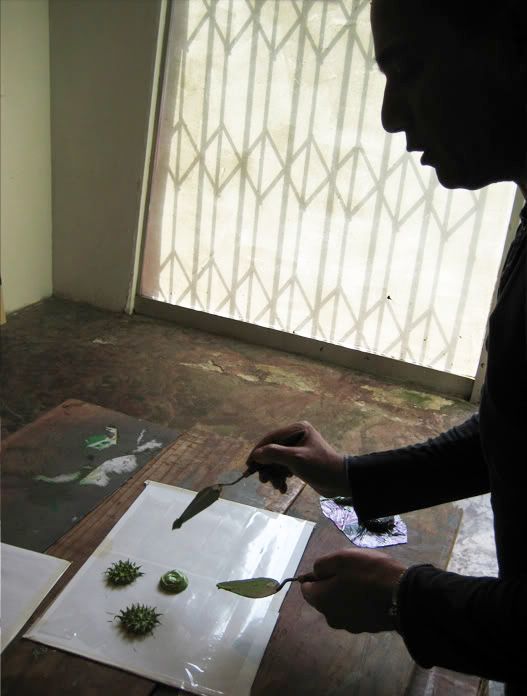 Dennis making a "monad"
Dennis making a "monad"Lately I've been reading a great deal about a widespread cultural schizophrenia- a discomforting cloud of confusion and uncertainty that seems to have descended upon us without warning. It's like we are adrift from ourselves, floating in a dissociative and numbing space of repetition, reduction, and denial. And it's not only in the art world that I feel these vibes, it's all around us, this pervasive vacuum of self. We're like drifters, amnesiacs, wandering mumbling through the streets, foraging through trash heaps and peering into other peoples lives in search of who we are to be, what we are to do in the face of the many challenges that lie in the future and that now have begun to cast an enormous shadow backwards in time. In our zeal to embrace the conceptual and the everyday, we have become disconnected from the spiritual path. If our souls are in fact able to be imagined at all, they are like ghosts in the network, disembodied, disincarnate, only evidenced by the transfer of information from one node to another- but never to be found, only adduced.

If we are to re-imagine a self that it is not disconnected and forlorn, if we are to follow our appetition for oneness and discard the meretricious cultural diversions that surround us like quicksand, it might be a good start to take a look the singular path that Dennis Hollingsworth has blazed in pursuit of his unblinking vision over the past decade. It is a misconception to think of alchemy as a pursuit that was based only on the seemingly vulgar and crass desire to turn base metals into gold. This is a reduction and misunderstanding of the true goal of the alchemist: to find a substance that would heal the corrupted world, and make real a universal panacea that symbolized the evolution from a diseased and polluted state into a healthy and vigorous world of the infinite. The spiritual metaphor for personal and social transformation that this search represented was called the philosopher's stone, or the lapis philosiphorum, and it was imagined as the great work, or magnum opus of any true alchemist. Once found, this sophic hydrolith would lead the alchemist into a higher state of being, one in which anything was attainable. Tantamount to this task, was the investiture of material elements with spiritual and metaphysical significance, for the alchemist's world was not a
 universe in which spirit had been disconnected from matter, but in which it flowed freely through a panopoly of multifarious physical states, manifest in the many elements and substances that came out of the earth. James Elkin's has recently articulated brilliantly the connection between alchemy and painting in his book, "What Painting Is", but making the jump to Hollingsworth's paintings is almost a task that completes itself, and we need look no further than the basic method that he applies for the full implications of the metaphor to become salient.
universe in which spirit had been disconnected from matter, but in which it flowed freely through a panopoly of multifarious physical states, manifest in the many elements and substances that came out of the earth. James Elkin's has recently articulated brilliantly the connection between alchemy and painting in his book, "What Painting Is", but making the jump to Hollingsworth's paintings is almost a task that completes itself, and we need look no further than the basic method that he applies for the full implications of the metaphor to become salient. monad, half done
monad, half doneRecently Dennis allowed me to photograph him in the process of creating a couple of "monads", the curious coral-like forms that seem to inhabit in abundance just about every piece that Dennis makes. Monadology, as first imagined by Giordano Bruno, and then later articulated by Liebniz, was an alternative to the Cartesian Dualism that would come later and make final the separation of matter and spirit. The monad is a self-contained, but everywhere present metaphysical unit, existing like the dewy drops in Indra's net, forming the etheric substrate of a field-like notion of connectivity and causality in which all is one and immanent. In this manner, the spagyric processes of alchemy become real, for like the primary dictum of "solve et coagula", we see the artist and his interaction with materials as a metaphor for the quest for alchemical gold. Remeber that in latin, gold is "aurum" or shining dawn, and I think it's not a stretch to think of this as the english "aura" that might be made manifest in a painting as the alchemical goal that Hollingsworth is reaching for. In the experiential concrescences and material accumulations of a studio based practice, we find before us the concretization of a powerful and liberating idea, that through the human manipulation of earthly material, we can transform experience into beauty, and make good on the promises that art has always potentiated. I see in Dennis' work a tremendous optimism and hope, a belief and affirmation that existence is good and noble, and that we must as individuals or artists re-connect to the task of lifting art and life into a higher order of being. It is from the intervention of a privileged domain, separate and distinct from the dross of the everyday, that we can find ourselves and be once again made whole. This is what Jung called psychic completion, the light of the self, the lux natura, the luminae de luminae, it's what we've been looking for all of these years. These paintings bring us one step closer.
Thank's Dennis.
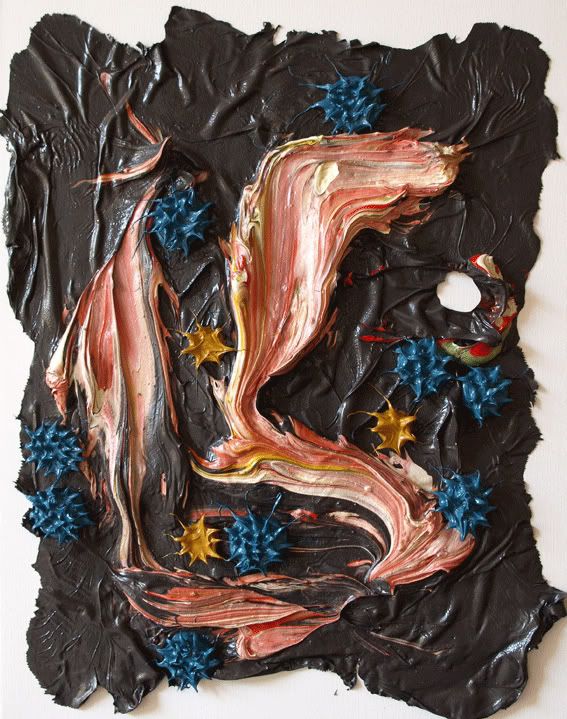 Dennis Hollingsworth, "Strange Loops"
Dennis Hollingsworth, "Strange Loops"
Wednesday, April 16, 2008
Tuesday, April 15, 2008
Saturday, April 12, 2008
Corpus Hermeticum
 Kittinger
KittingerThe myth of our society is the existential myth that we are cast into matter, that we are lost in a universe that has no meaning for us, that we must make our meaning. This is what Sartre, Kierkegaard, all those people are saying, that we must make our meaning. It reaches its most absurd expression in Sartre's statement that nature is mute. I mean, this is as far from alchemical thinking as you can possibly get because for the alchemist nature was a great book, an open book to be read by putting nature through processes that revealed not only its inner mechanics, but the inner mechanics of the artifex (person performing experiment)-the person working upon the material, in other words, the alchemist.
Imagination. I think this is the first time I've used this word this evening. The imagination is central to the alchemical opus because it is literally a process that goes on the realm of the imagination taken to be a physical dimension. And I think that we cannot understand the history that lies ahead of us unless we think in terms of a journey into the imagination. We have exhausted the world of three dimensional space. We are polluting it. We are overpopulating it. We are using it up. Somehow the redemption of the human enterprise lies in the dimension of the imagination. And to do that we have to transcend the categories that we inherit from a thousand years of science and Christianity and rationalism and we have to re-empower and re-encounter the mind and we can do this psychedelically, we can do this yogically, or we can do it alchemically and hermetically.
Now there is present in the world at the moment, or at least I like to think so, an impulse which I have named the archaic revival. What happens is that whenever a society really gets in trouble, and you can use this in your own life-when you really get in trouble-what you should do is say "what did I believe in the last sane moments that I experienced" and then go back to that moment and act from it even if you no longer believe it. Now in the Renaissance this happened. The scholastic universe dissolved. New classes, new forms of wealth, new systems of navigation, new scientific tools, made it impossible to maintain the fiction of the Medieval cosmology and there was a sense that the world was dissolving. Good alchemical word-dissolving. And in that moment the movers and shakers of that civilization reached backwards in time to the last sane moment they had ever known and they discovered that it was Classical Greece and they invented classicism. In the 15th and 16th century the texts which had lain in monasteries in Syria and Asia Minor forgotten and untranslated for centuries were brought to the Florentine council by people like Gimistos Placo(sp?) and others and translated and classicism was born-its laws, its philosophy, its aesthetics. We are the inheritors of that tradition but it is now, once again, exhausted and our cultural crisis is much greater. It is global. It is total. It involves every man, woman and child on this planet, every bug, bird and tree is caught up in the cultural crisis that we have engendered. Our ideas are exhausted-the ideas that we inherit out of Christianity and its half-brother science, or its bastard child science. So, what I'm suggesting is that an archaic revival needs to take place and it seems to be well in hand in the revival of Goddess worship and shamanism and partnership but notice that these things are old-10,000 years or more old-but there was an unbroken thread that, however thinly drawn, persists right up to the present.
Terence McKenna
 Ryan McGinley
Ryan McGinley
Friday, April 11, 2008
reverbnation

...in case you haven't noticed the latest bell and whistle of my eponymous blog...reverbnation everyone !
So far I've managed to upload plenty of McKenna, some McLuhan, Sheldrake, and recently some great JG Ballard interviews. Maybe I'll start uploading my telephone conversations or messages...like in that one Sonic Youth song from "Daydream Nation" where Thurston's dad keeps talking about taking out the trash. So many possibilities...
If it's annoying just press pause and you'll be saved the indoctrinization.
Tuesday, April 8, 2008
Clarence
Saturday, April 5, 2008
John Martin
Friday, April 4, 2008
Rupert Sheldrake Stabbed in Leg
McKenna comrade in arms, behavioral scientist and progressive thinker stabbed by disturbed man at conference.
Sheldrake in better, less life threatened, days:
Dumbass Self-Satisfied Reactionary Positivistic Materialist reacts with thinly veiled glee:
Sheldrake in better, less life threatened, days:
Dumbass Self-Satisfied Reactionary Positivistic Materialist reacts with thinly veiled glee:
Dr. Rupert Sheldrake, purveyor of pseudoscientific silliness (or “woo” as James Randi likes to call it) like telepathy in animals, was stabbed in the leg at a medical conference in Santa Fe NM yesterday, apparently by some guy from Japan. The injury was not life threatening, and his attacker was arrested.
Sheldrake’s big idea is something called “morphic resonance“. The idea is that all living things are connected together by a telepathic internet of sorts. And yet the news report (linked above) refers to him as “a world renowned behavioral scientist”, yeah right.
Thursday, April 3, 2008
TASSILI (Algeria)
Better than Darger.....well let's just say different.
From mountain ranges of the Atlas to the North, to Sudan to the South, and from Egypt to the East, to the Atlantic Ocean to the West. With 8 million square kilometers, this desert is a really difficult place for any type of archaeological or scientific investigation. In 1933 an official of the mehariana policia, Brenans lieutenant, crossed in police functions the zone of the Tube of Tassili-n-Azyer and arrived at a denominated valley Ighargharen. Brenans discovered between...
The rocky walls everything an enormous painting group improbable (more than 5,000) done on the stone. Before his eyes there were representations of giraffes, gigantic elephants with the tube in stop, hipopótamos, animals and humanoides figures. But he was explorer Henri Lhote whom it presented the entire world this one finding Prehistoric Art in year 1.957. Henry Lhote classified the great amount of pictografías in twelve groups: - Beings of round head.
And horns of small size. - Devils. - Drawings of the average period with men of round head. - Men of evolved round head. - declining Period of the round heads. - Men of round head very evolved. - Period of the peace judges or terminal. - longilíneos white Men of the prebovidense period. - Hunters with corporal paintings of the old bovidense period. - bovidense Style. - Period of the cars. - Period of the mounted horses or the bitriangular men. Of all paintings most...
Amazing she is the one than one sees a species of diver with his complete suit and diving apparatus with grooves in his frontal part that reflects to have a clumsy movement giving the impression of levitar or flying tied to something by means of a long cable. To this drawing, of six meters of height, Henry Lhote the great Martian God called "". Another very interesting painting is the one that was baptized as "the fluted woman" and represents a feminine figure (that seems is floating)...
With long arms extended backwards, towing to another being put of knees and bent towards ahead with indifferent gesture to the scene, whereas another one appears leaving a strange disc. Peculiarly there are many discs made in dierentes colors and all seem to be floating. Tassili has been declared by UNESCO like Cultural Patrimony of the Humanity and for some experts it is "the Sistine Chapel of the paleolítico", with paintings that in some cases reach the 10,000 years of antiquity.
Wednesday, April 2, 2008
Subscribe to:
Comments (Atom)



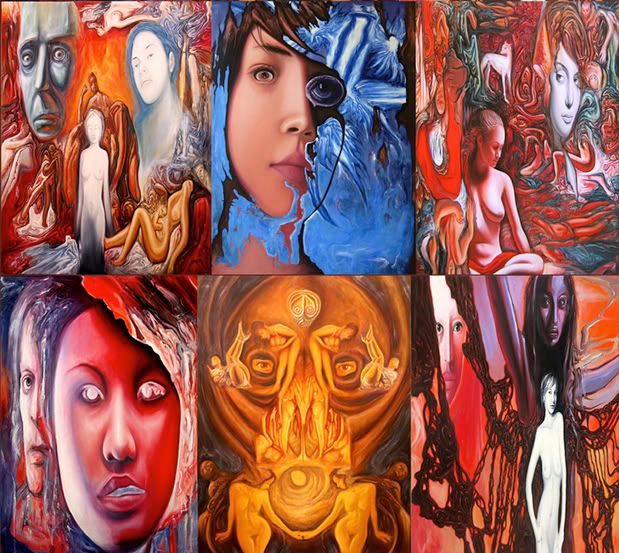 Hermetic Order of the Golden Dawn
Hermetic Order of the Golden Dawn
 Naomi Hui
Naomi Hui


















